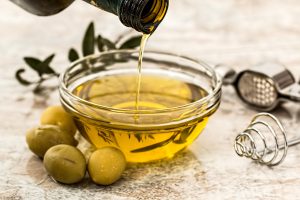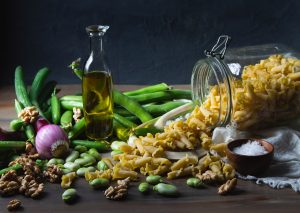The Healthiest Cooking Oils
You almost certainly use some oil in your cooking, regardless of your diet: It’s a common ingredient in the preparation of vegetables, meats, eggs, sauces, and other foods, adding texture, lubrication, and flavor. When it comes to nutrition, though, not all cooking oils are made equal.
“A healthy cooking oil is one that is primarily composed of monounsaturated or omega 3 fatty acids,” says Kylene Bogden, R.D., co-founder of the nutrition coaching firm FWDfuel.
When it comes to an oil’s healthfulness, however, the composition in the bottle is only part of the story. The smoke point, or the temperature at which the oil no longer remains stable, is another important factor. Oils have a range of smoke points, and you shouldn’t cook with them above this temperature. So, depending on what you’re cooking, the healthiest cooking oil is one that can withstand high temperatures.
“Each oil has a different smoke point,” explains Noah Quezada, R.D.N., and CEO of Noah’s Nutrition, “which is the temperature at which the oil begins to break down and release hazardous compounds.” “When cooking, it’s critical to utilize oils with a high smoke point because overheating oils can result in the release of dangerous compounds.”
To reap the nutritional benefits of cooking oil, you must first desire to use it.
“Are they nutritive oils themselves and can they withstand the heat?” Wendy Bazilian, DrPH, R.D.N., suggests using this three-prong test to choose your oils: “Are they nutritive oils themselves, and can they handle the heat?” Not to mention, do you enjoy the taste of them enough to get the benefits of using them?” “Tasty oils can help make foods we need more of in our diet – like vegetables – more pleasant and hence simpler to consume more of,” she says.
What makes cooking oil good for you?
Healthy cooking oil is one that is high in monounsaturated and polyunsaturated fats and low in saturated and trans fats. “Any of these can be a health victory when they replace a less nutritious oil or are combined with another oil,” Bazilian notes.
The American Heart Association suggests using oils with fewer than four grams of saturated fat per tablespoon and no partially hydrogenated or trans fats.
Cooking oils that are the healthiest to use
Oil made from vegetables
Soybean oil has traditionally been used as vegetable oil. However, the phrase can now be applied to a mixture of several oils.
Soybean oil is mostly made up of polyunsaturated fats (61 percent polyunsaturated fat, 24 monounsaturated fat, and 15 percent saturated fat). Soybean oil also contains omega-3 fats, which are heart-healthy lipids commonly found in salmon and sardines but less commonly found in plant-based foods.
Soybean-based vegetable oil has a neutral flavor and lacks flavor. Nonetheless, she noted, it’s a versatile, all-purpose cooking oil that can be used for sautéing and frying as well as salad dressings.

Extra-virgin olive oil is typically recommended for cooking since it is high in heart-healthy monounsaturated fats
Olive oil
According to Dana Ellis Hunnes, a senior dietitian at UCLA Medical Center and author of Recipe For Survival: What You Can Do to Live a Healthier and More Environmentally Friendly Life, extra-virgin olive oil is typically recommended for cooking since it is high in heart-healthy monounsaturated fats. These are anti-inflammatory and aid in the reduction of LDL cholesterol. “However, because it has a low smoke point, it’s best utilized as a salad dressing, a pasta topper, or for a low-slow cook,” she says. “It has a lower smoke point because it contains more microparticles from the olives themselves, giving it a greener tint.”
Regular olive oil is also nutritious and contains monounsaturated fats, but it is not as anti-inflammatory as extra virgin olive oil because it has been processed further and some of the plant components (phytonutrients) have been removed. “However, because it can be cooked at a higher temperature and has a greater smoke point, it’s excellent for pan-frying and searing,” Hunnes explains.
Peanut oil is a type of vegetable oil
This healthful monounsaturated oil, which is especially popular in Asian cuisines, has a high smoke point and can be used to deep-fat fry, however, Hunnes warns that doing so would “negate its health benefits.” “Despite its peanut derivation, it is a flavorless oil,” she adds, which might be beneficial for taste neutrality and variety in meals.
Sesame seed oil
Sesame oil has a healthy balance of polyunsaturated fat (46%) and monounsaturated fat (40%) and is commonly used in Asian, Indian, and Middle Eastern cookery, according to Lichtenstein. Saturated fat makes up the remaining 14%. She explained that it isn’t typically used as a cooking fat, but rather for its powerful flavor.
Sesame oil, especially toasted sesame oil, which has a darker color and stronger flavor, adds a nutty flavor to any dish. After opening the sesame oil, keep it refrigerated.
Avocado oil
Avocado oil has a high smoke point of 520 degrees Fahrenheit (and unrefined at 375 degrees). It’s also high in monounsaturated fats and flavorless, making it ideal for baking.
“Avocado oil is a fantastic cooking oil that contains some, but not all, of the nourishment, that the whole avocado contains,” Bazilian explains. (However, “while avocado oil is good for sautéing, it is fairly pricey,” Adams adds.)
Oil made from grapeseeds
According to the Academy of Nutrition and Dietetics, this multipurpose cooking oil is made from grape seeds left over from wine production. Grapeseed oil has a mild flavor that may be mixed with other, stronger flavors, making it a favorite of chefs and foodies. It’s a versatile oil that may be used for sautéing and roasting, as well as salad dressings. Grapeseed oil should be kept refrigerated to avoid becoming rancid, according to food experts.
According to Lichtenstein, grapeseed oil has a similar fatty acid profile to soybean oil (61 percent polyunsaturated fat, 24 percent monounsaturated fat, 15 percent saturated), with a high percentage of polyunsaturated fat (71 percent polyunsaturated, 17 percent monounsaturated, 12 percent saturated).
Little is known about the effects of grapeseed oil on human health, according to a 2016 review of studies published in the journal Nutrition and Metabolic Insights. A few researchers have looked into the benefits of this mainly polyunsaturated fat on heart health.
Canola oil is a type of vegetable oil
Canola oil has a low saturated fat content and a smoke point of 400 to 450 degrees. “This makes it a fantastic alternative for recipes that demand mild flavors,” Quezada explains, citing its lack of flavor.
Chia seed oil
This oil is less well-known among casual chefs in the United States, but it is beginning to gain traction, according to Bazilian. “It has a very high smoke point and is stable at high temperatures due to its rich antioxidants that remain in the cooking oil,” she says, recommending it as a healthy oil.

A healthy cooking oil is one that is primarily composed of monounsaturated or omega 3 fatty acids
Cooking with Healthy Oils: Tips
Most home-kitchen uses, including higher-temperature cooking like stir-frying and pan-frying, are safe with the healthier oils listed below. Deep-fat frying is not a cooking method we advocate.
Once the oil reaches its smoke point, it begins to deteriorate. So, if your oil unintentionally smokes or catches fire, throw it out and start over.
If the oil has a terrible odor, don’t use it. When oil is stored for an extended period of time, it can become oxidized or rancid. It will have a distinct odor, which you should eliminate.
Cooking oil should never be reused or reheated.
To avoid wasting cooking oils, buy them in smaller containers and store them in a dark, cool location.
What makes cooking oils “unhealthy”?
Even among certified nutritionists, there is a lot of subjectivity in our reporting, although some oils are generally deemed unhealthy because they contain significant levels of saturated and/or unhealthy unsaturated fats. “The most unhealthy are partially hydrogenated oils found in foods like shortening since they frequently contain trans fats,” Adams explains. “Trans fats are man-made fats that are generated by adding hydrogen to vegetable oil.”
Trans fats have been related to heart disease because they lower “good” cholesterol (HDL) while increase “bad” cholesterol (LDL). Look for “partially-hydrogenated oil” on the ingredients list to see if you’re cooking with trans fats.
You can identify which oils contain saturated fat without looking at the label or investigating the ingredients because they are solid at room temperature, according to Adams.
“Oils that are less than optimal to use are very refined and possess a greater omega 6 to omega 3 ratio, a ratio that, if consumed regularly, can considerably contribute to inflammation,” Bogden continues.
Cooking oils should be used sparingly
Palm oil contains a lot of palmitic acids, which is “a form of saturated fat associated with an elevated risk of heart disease and other chronic ailments,” according to Quezada.
Butter is heavy in saturated fat and trans-fatty acids, both of which have been linked to an increased risk of heart disease, according to him.
Sunflower oil has a high smoke point, but Lisa Young, Ph.D., a qualified dietitian, says it includes a lot of omega 6 fatty acids. “Eating too many omega 6s without balancing them with omega 3s might contribute to inflammation, so you may want to limit this oil.”
Margarine is high in saturated and trans fats, both of which are harmful.
So, what’s the big deal about coconut oil?
Coconut oil was a hot topic among the numerous dietitians who provided feedback for this piece. Some people thought it was healthy, while others didn’t.
“Some individuals enjoy coconut oil, while others believe it should be avoided, depending on who you ask. “This is due to its high saturated fat level,” adds Dr. Young. “When compared to other plant oils, coconut oil is primarily saturated fat. According to the American Heart Association, “items high in saturated fat, such as coconut oil, should be replaced with meals high in unsaturated fats, such as olive oil.”
It’s wonderful for cooking because of its high smoke point, but it should be consumed in moderation due to its high saturated fat level, she explains.
Bazilian is on board with the strategy. “Coconut oil, which has gotten a lot of attention,” she continues, “is actually a saturated fat with a shorter chain and may be taken in moderation.”




